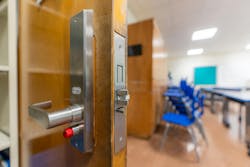School Safety and Security Revolutionized with Technology
If you keep up with the latest tech news, you’re probably familiar with buzzwords like artificial intelligence (AI) and biometrics. They’re making waves in various industries. But did you consider that these advancements can also be crucial in enhancing school safety and security?
When most people think of school safety and security, they often jump to surface-level measures like door locks and legislation. However, these approaches have layers and multiple components, from policies and procedures to video security, detection, and alarms. Technology opens up a new world of possibilities for creating safer learning environments.
A Leader in Physical Security and Cybersecurity
To explore this topic further, Kasia Hanson, global director of physical and cybersecurity ecosystem and partnerships at Intel, shares her industry expertise and explains how technology can enhance physical security and cybersecurity for K-12 schools.
With her extensive industry experience, including over 20 years at Intel, Hanson recognizes technology’s potential to help advance school safety and security beyond where we are today. She’s worked alongside hardware and software partners, integrators, and Fortune 500 companies to identify opportunities to enhance cybersecurity and physical security for organizations of all sizes—including nonprofits like PASS. She also knows that more must be implemented to increase school safety and the policies that guide it.
“I have a genuine passion for school security for three compelling reasons: firstly, it is a matter that concerns us all; secondly, as a mother, it holds personal significance to me; and lastly, my work at Intel provides me the opportunity to enable change,” she said.
Breaking Down the Silos with Technology
Schools may face various roadblocks in their approach to safety and security, but creating an ecosystem that can support safety and security strategies and policies will help immensely, Hanson said. She believes that schools can benefit from functioning within an ecosystem that capitalizes on the latest security advancements, including access control and AI, while also considering privacy laws and the impact of technology on students, teachers, and administrators.
“School security takes a village … it’s not just one and done—we must continually evolve and advance protections of our schools, children, teachers, and community,” Hanson said.
At the heart of the issue lie two concerns: the need for more standards and guidelines for protecting schools and the reluctance of some stakeholders and communities to use advanced technology to address the necessary changes, Hanson said. Some states have set guidelines for securing school facilities, while others continue to develop their own standards.
Hanson emphasized the value and need for road maps and playbooks, similar to the PASS School Safety and Security Guidelines, enabling districts to develop and evolve their policies and procedures. Simultaneously, she emphasizes the importance of fostering a deeper understanding of emerging technologies among educational leaders, enabling them to understand how the technology can be used while assessing current safety levels and paving the way for improvement.
For example, Hanson recalled when she spoke with a school district and offered them a free security assessment. The assessment uses digital twin technology, a 3D, interactive re-creation of the school’s layout, to understand the landscape and reveal weaknesses in an emergency. Although the assessment could have provided the school with valuable insights, the district declined. Their concern was how to explain it to parents.
Advancing School Security Through Technology
Hanson recognizes that privacy concerns are often at the forefront of discussions on implementing technology in public spaces. However, she envisions ethical and purposeful applications of AI technologies that can bring about positive change. For instance, utilizing 3D digital twins—a technology that recreates a school’s layout in a 3D interactive manner—can enable school officials and first responders to better prepare for emergencies by virtually simulating real-life scenarios.
AI-powered video can be a helpful tool. Traditional video technology acts as a resource after an incident occurs. However, with AI-powered video analytics, school officials can receive real-time alerts before incidents happen or perhaps about to happen, such as if a weapon is detected.
From AI and machine learning to deep learning and computer vision, when it comes to physical security, Hanson sees multiple opportunities for technology to help schools create a safer, more secure environment while adhering to privacy policies.
Schools can take a crucial step by regularly reviewing and assessing their security practices, policies, and vendors. This is important because technology is constantly advancing, and it’s essential to ensure that policies and technology are up to date and aligned. Hanson said the technology provides value at various levels to enhance school safety and security.
About PASS
The Partner Alliance for Safer Schools (PASS) is a nonprofit 501(c)(3) bringing together expertise from the education, public safety, and industry communities to develop and support a coordinated approach to making effective and appropriate decisions concerning safety and security investments. Download the complete PASS Guidelines or check out our PASS Safety and Security Checklist for quick start tips. These resources and whitepapers on various topics are free, including barricade devices, lockdown drills, and more.
